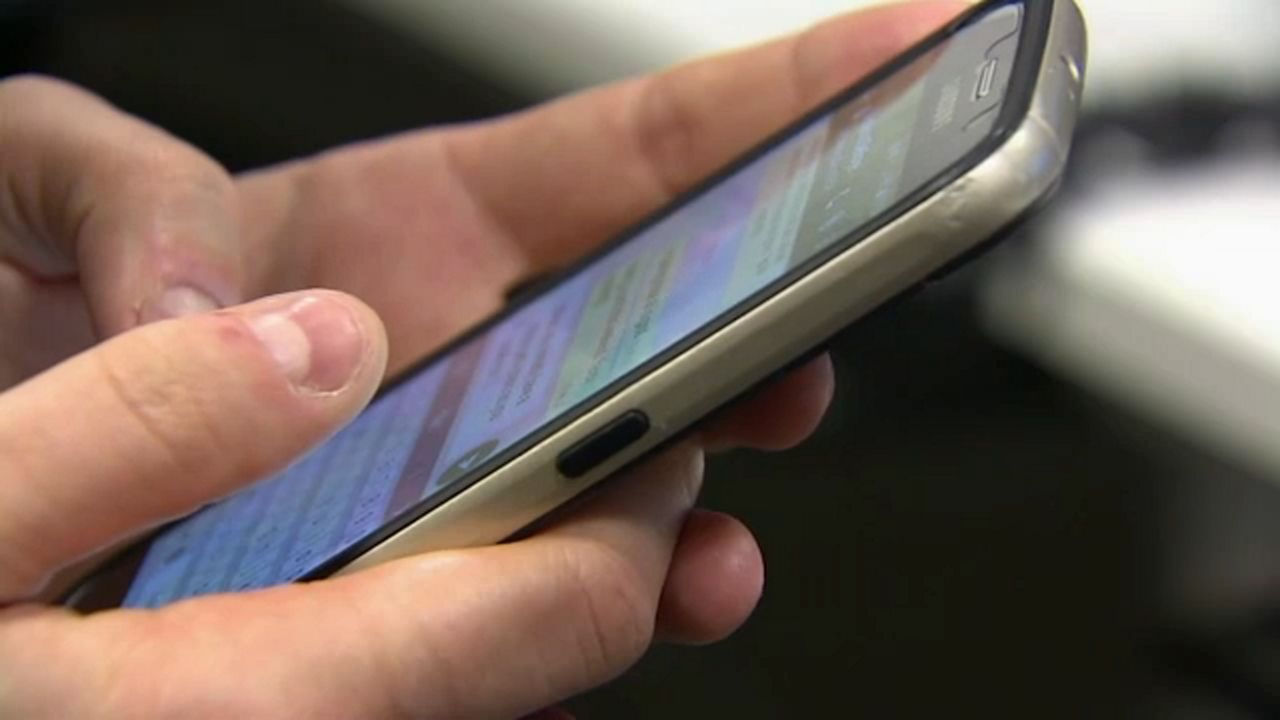Editor’s note: The woman identified as Amanda is the mother of child who was caught sexting. To ensure the protection of her daughter’s identity, Amanda is not her real name.
Her daughter was not acting like her daughter. She preferred to stay secluded from the rest of her family. Her room became her sanctuary. That was the first sign.
A concerned stepmother finally decided to look for possible answers in her phone. What she found she said was something that falls under the umbrella of a parent’s worst nightmare.
“She was sexting, yes,’’ said her biological mother, Amanda, who lives in Oshkosh.
Her daughter’s phone was taken away. She was grounded. She was lectured; everything you would expect a parent to do. None of it worked.
“She was finding other means to get a phone,’’ said Amanda. “She was asking her friends for phones they weren’t using anymore and she was using the WiFi and we stumbled across that.
“We took over as parents and tried to combat the issue just on a parental level, and when we couldn’t combat the situation by ourselves, we actually reached out to the school liaison officer and talked to him on what we could do. What were our options?”
But all options failed, until there was just one left.
“When it progressed to the point where we didn’t know what else to do, we willingly handed over the phones and the evidence to the police department for them to do an investigation,’’ said Amanda, “because it was getting out of hand. It wasn’t just her. There were other kids involved.’’
Enormous disappointment in her child quickly transformed into fear, she said.
“Not only in my household, but also in her father’s household, we have younger children and we were terrified something would happen,’’ she said, noting her daughter was sexting with people she did not know and only knew them on a first-name basis. “Somebody would find her, or meet her, or she’d be out with her siblings, and with the sex trafficking and everything else going on it was more of a terrifying experience. We had to stop it.’’
Amanda’s daughter, along with the other students involved, were issued citations. They had to appear in court and stand in front of judge. And none of them had any clue of the kind of trouble they were in.
In Wisconsin, teen sexting falls under its laws on child pornography, sexual exploitation of a child, and causing harm to a child — all of which are felony offenses. The state defines a teenager as someone who's under the age of 18.
Their futures — the ability to get into the college or tech school of their choice, a military career, or any job they applied for — for the rest of their lives, would be in jeopardy.
What they also didn’t know there was a group of local people, and one man in particular, who created a diversion program that, if completed successfully, would enable teens to have that charge dismissed. It was their second chance. A chance of a lifetime, really, to erase the kind of stupid mistake that the vast majority of humans have made in their teenage years.
But the mistakes of most parents today did not carry these kinds of consequences.
“So when the judge actually gave us the opportunity, we jumped on it,’’ Amanda said. “Just kind of a, 'This is your second chance. You take this class, and you need to learn from your mistakes,' instead of, basically, ruining your whole life.’’
****
Bryan Wright’s plate was already overflowing. The idea of attending another board meeting was as appealing as a double root canal.
“My boss told me, ‘You’re going to this meeting,’’’ Wright said. “I was like, ‘Ah, man!’’’
It was a social media task force meeting, attended by leaders from various Winnebago County disciplines, including law enforcement, the district attorney’s office, school officials and human services.
“And that group kind of identified sexting as something that was problematic,’’ said Eric Sparr, deputy district of Winnebago County, “and they just weren’t doing anything with it. And then when started having those conversations, it was really coming from the schools.”
Sparr wanted to know just how extensive this problem was within the schools, so he reached out to several school resource officers. And one conversation stood out.
“One of the officers, that was in one of the larger high schools in the area, when we were first talking about this, I said, ‘Hey, how many of these do you see?’’’ Sparr said. “And this liaison says, ‘We see it plenty.’ Actually, what the officer said was, ‘Hundreds in a year. Hundreds of situations where it would come up,’ in varying degrees.’’
And that was just one high school.
“Once we started talking about it, we realized it was a dangerous situation if it didn’t get addressed in some way,’’ said Sparr.
He said Amanda’s concerns over her daughter getting caught up in sex trafficking were not overstated.
“I think that situation is extreme, but it definitely happens where some of the kids are putting themselves at significantly increased risk for that sort of thing to happen,’’ he said.
“I think the more common situation, probably less dangerous but still scary, is they’re sending stuff to people that they know. And then it can be used in different ways. Maybe when they send it they’re in a relationship, or they’re trying to get into a relationship, and then things go sour and pictures end up getting shared or something like that. And what we saw a lot of was kind of the negative impact of that on someone’s mental health, or it became like a bullying situation, or someone who then had power over someone else and they had put them into a position where they might make them do things they didn’t want to do," he added.
The question became how could they best handle this growing problem?
“There were different ways it could have been addressed, and one of those would have been to prosecute all these people in the juvenile court system for child pornography which just is not, it just was not a good solution," Sparr said. “That has lots of other implications on the offenders and creates a lot of headaches for victims if everybody has to go through this court process if they want to contest. And so, that wasn’t a really viable option, and so we needed something.”
And that’s when the guy who didn’t want to go to this meeting raised his hand.
“I walked up to Officer Pete Ehlert (Community Programs liaison officer for the Winnebago County Sheriff’s Office) and Eric Sparr and said, ‘I’ll create you a program,’’’ said Wright, who at the time was a prevention educator for Reach Counseling and Christine Ann Domestic Abuse Services. “And they basically had that moment of, ‘What are you talking about? What do you mean you’ll just create a program?’ I was like, ‘Yeah, I’ll write, develop and create you a program.’’’
Through his 13-plus years of experience in domestic and sexual violence, Wright knew two things to be true.
“I was always taught you need to do more with less,’’ he said. “And if you wanted something, you were better off doing it yourself.’’
Wright, a Shawano native and graduate of UW-Oshkosh, believed some of the best expertise he could tap into was the people he worked with, for he knew they had their boots on the ground daily and understood how families and kids were impacted in difficult situations.
“So who is better to have the resources and information that you want to put together and layout in a way that can get to the actual causations and the reasons for the why?’’ Wright said. “Any successful program, you first need to get to the ‘why’ of what’s causing this in the first place, and how are we addressing the issues that these teens are dealing with because it’s not the causation, like sexting. There's way more things that occur way before it gets to the point of where a teen is feeling comfortable, or having sexting being normalized in the first place.’’
While explaining the legal ramifications was part of it, Wright developed a series of exercises that built off of one another, to help teens understand the all-important ‘why’ when it came to their behaviors.
He worked with three of his former criminal justice professors at UWO to create a standardized test and pre-and post-evaluation forms that would gauge a student’s demeanor, behavior and mentality of each teen from week one to week six.
“We can literally see how effective, not only each activity, but each week, and each session, they’re improving from the messages they’re getting from those,’’ Wright said.
What they’ve found is that teens are reporting a high significance and understanding in certain areas, such as perpetrator mentality, the idea of hypersexualization in today’s culture and its influence on them, and how it can perpetuate and lead to high levels of sexual abuse and assault. And they’re also seeing significant jumps in teens’ self-esteem, and several are improving their grades in school.
“What I loved about the curriculum that Brian put together was that it’s not just talking about (the legal ramifications), that’s a very small aspect of the class,’’ said Ehlert. “One of the things I think we see, and have seen over time, is desensitizing sexual contact, desensitizing what it is to be a man, what it is to be a woman, and getting kids to understand that these are people, they’re not objects.
“And sometimes that’s difficult because you don’t have to look very far — you watch television shows, watch movies— and you don’t watch it 10 minutes and there is sexual connotation in there immediately. In the dialogue, in the actions, whatever. And getting young people to understand that these are real people, I think, is more important even so than understanding the consequences, so that we learn how to treat each other as better people, as human beings, rather than as an object.’’
Wright said he is just in the beginning stages of measuring recidivism, but of the 150 teens whose cases have been followed up on thus far, there has been only one repeat offender.
****
Wright said he has seen his program start to gain traction. It is now in 22 counties in Wisconsin and is being picked up by other states, and one has started in Barcelona, Spain.
This is a teen issue and, thus, a worldwide problem.
While Wright’s social media texting program is being used in different forms — as part of a school’s health department or health education, used as preventive curriculum, used by health and human services, or as part of deferred prosecution programs — he hopes it will be utilized mostly as a diversion program.
For, that way, it eliminates any paper trail.
“I always inform parents that once a paper trail is created, it can be found or traced and reviewed,’’ Wright said. “With things becoming as competitive in the world as it is, any paper trail created is a chance that a company, military for sure can find it, and even bigger universities have the chance to find it. If the record is dismissed, it will still show up and has the potential to be found.
“Sexual offense against a child? Nobody looks further into the story of it. Like, ‘Oh, it was a 15- and 17-year-old.’ No, people just see ‘child offense’ and they go, ‘No.’ And then that application is tossed. There’s no looking beyond that.’’
Wright is the founder and owner of Dynamic Family Solutions, LLC, which develops specifically tailored educational curriculum and materials for organizations and agencies working with families and youth, who are enduring life-altering and critical issues.
He spends much of his time today training facilitators for his diversion program around the state and country.
“To have him as a facilitator, at least early on, was incredibly valuable because he’s so good at it,’’ said Sparr, “because he’s so engaged, and people respond to him and that really helps to make sure people were getting out of it what we hoped they would.
“And that’ll be an ongoing challenge as it spreads around to different school districts or other agencies; that their challenge is always to find an appropriate facilitator. We never had to worry about that because we had one.’’
****
Amanda’s daughter was initially reluctant to attend the diversion program, and Amanda herself was on edge.
“I guess she didn’t understand fully what the class was about, but who does?” said Amanda. “But once she got into the actual class and she started doing the work and she felt more comfortable going through everything because it wasn’t a class that seemed, I guess, they didn’t shame her.”
And for Amanda, the diversion program did everything she hoped it would, and more.
“As the class was even going on, I noticed changes in my daughter,’’ she said. “I noticed that she wasn’t; her attitude changed. It wasn’t, ‘Mom, it’s no big deal. It’s just a picture.’ She really started to sit back and think about what she did, what repercussions it could have. Her self-imaged changed. She started focusing not more on the boy aspect of, ‘The only way I can get him to like me is if I sext, or if I do this.’ It was just, ‘No, I’m not going to stand for this. This is not OK. This is not something that I want to be known for.’
“And she did a complete 180. She went from, being a teenager that, I don’t want to say didn’t care, but didn’t think it was a big deal, to ‘Well, mom, can I start work? Can I find a job?’ Trying to be more responsible in the aspect of ‘I’m not worried about what a boy thinks, or what he wants because this is me and I’m not going to expose myself. It’s not OK.’ So she changed. Her grades got better. She’s just a different child.’’
If you want more information on the teen sexting intervention program, visit their website here.
Story idea? You can reach Mike Woods at 920-246-6321 or at: michael.t.woods1@charter.com.









